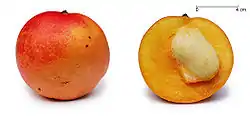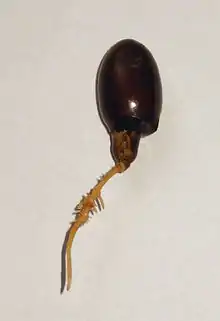Recalcitrant seed
Recalcitrant seeds are seeds that do not survive drying and freezing during ex-situ conservation.[1] By and large, these seeds cannot resist the effects of drying or temperatures less than 10 °C (50 °F); thus, they cannot be stored for long periods like orthodox seeds because they can lose their viability. Plants that produce recalcitrant seeds include avocado, mango, mangosteen, lychee, cocoa, rubber tree, some horticultural trees,[2] aquatic plants, such as Nymphaea caerulea,[3] and several plants used in traditional medicine, such as species of Virola and Pentaclethra. Generally speaking, most tropical pioneer species have orthodox seeds but many climax species have recalcitrant or intermediate seeds.[4]

Mechanisms of damage
The two main mechanisms of action of damage to recalcitrant seeds are desiccation effect on the intracellular structures and the effect of metabolic damage from the formation of toxic chemicals such as free radicals.[5] An example of the first type of damage would be found in some recalcitrant nontropical hardwood seeds, specifically the acorns of recalcitrant oaks, which can be stored in a nonfrozen state for up to two years provided that precautions be taken against drying. These seeds showed deterioration of cell membrane lipids and proteins after as few as 3–4 days of drying.[6] Other seeds such as those of the sweet chestnut (Castanea sativa) show oxidative damage resulting from uncontrolled metabolism occurring during the drying process.[7]
References
- "Frequently Asked Questions". National Center for Genetic Resources Preservation, USDA. Archived from the original on August 19, 2007. Retrieved 2008-01-09.
- Marcos-Filho, Julio. "Physiology of Recalcitrant Seeds" (PDF). Ohio State University. Archived from the original (PDF) on January 24, 2014. Retrieved December 3, 2014.
- "埃及藍睡蓮種子的冷凍保存 — 使用添加穀胱甘肽的植物抗凍配方__國立清華大學博碩士論文全文影像系統". etd.lib.nctu.edu.tw. Retrieved 2018-04-30.
- Flores, E.M.; J. A. Vozzo Editor. "Ch 1. Seed Biology" (PDF). Tropical Tree Seed Manual. USDA Forest Service. Retrieved 2011-12-24.
- Berjak, Patricia; N.W. Pammenter; J. A. Vozzo Editor. "Ch 4. Orthodox and Recalcitrant Seeds" (PDF). Tropical Tree Seed Manual. USDA Forest Service. Retrieved 2010-09-27.
- Connor, Kristina F (2004). "Update on oak seed quality research: Hardwood recalcitrant seeds". Proc. RMRS. USDA, Rocky Mountain Research Station. P (33): 111–116. Retrieved 2008-01-09.
- Leprince, Olivier; J Buitink; F Hoekstra (1999). "Axes and cotyledons of recalcitrant seeds of Castanea sativa Mill. exhibit contrasting responses of respiration to drying in relation to desiccation sensitivity". J. Exp. Bot. Oxford University Press. 50 (338): 1515–1524. doi:10.1093/jexbot/50.338.1515.
